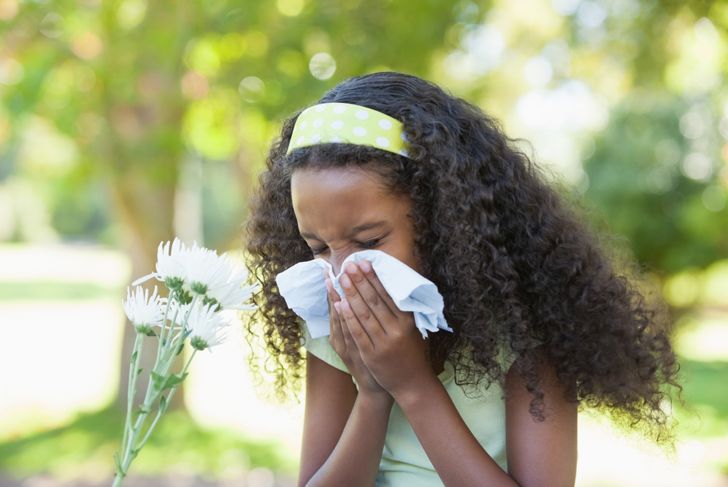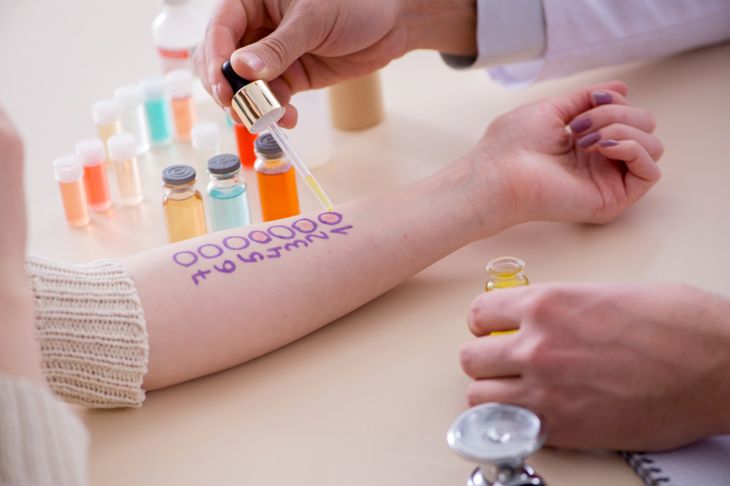When the immune system sees foreign substances that it deems harmful, it produces antibodies to protect the body. People with an allergy have an immune system that identifies as harmful substances that are normally harmless. An allergen is anything that triggers symptoms of an allergic reaction. These symptoms negatively affect the quality of life and may need to be identified and treated.
Urticaria (Hives)
Hives are one of the most common and annoying allergy symptoms. They are raised red or skin-colored bumps that may appear and disappear suddenly, causing the skin to itch intensely. They often resemble bug bites and can erupt anywhere on the body. If a person presses the center of a red hive, it will turn white or “blanch.” Hives are not stationary but can move around and change shape. Common triggers for hives include eggs, peanuts, and nuts. Medications, pollen, pet dander, and plants can also trigger this response. Not all hives are an allergic reaction, however.
Allergic Rhinitis (Hay Fever Symptoms)
Red, watery eyes, sneezing, runny nose, and nasal congestion are all signs of allergic rhinitis. Various allergens such as pollen, mold, animal dander, and dust mites set off an inflammatory reaction, leading to excess mucus production, watery, itchy eyes, coughing, sneezing, and nasal congestion. This condition is nearly identical to the common cold, but it appears more in the spring and fall and can be diagnosed by an allergist.
Digestive Issues
Digestive symptoms are a common reaction to food allergies. People may experience cramping, diarrhea, heartburn bloating, or nausea due to their bodies mistakenly attacking certain proteins in foods. Nuts, chocolate, dairy products, fish, and wheat are just a few that may trigger these allergic symptoms.
Headaches
Allergic headaches make up a small percentage of all headaches, but they are a significant symptom for some people with allergies. An allergy headache usually includes pain in the sinus area, sometimes on only one side. They tend to throb instead of being a steady pain, and they may be accompanied by nausea. Triggers for an allergy headache include wine, smoke, and stress.
Conjunctivitis
Conjunctivitis, also known as red or pink eye, results from either an infection or an allergy. The condition usually appears in both eyes and causes redness, burning, and itching. The eyes may also produce pus and water profusely. Allergic conjunctivitis is not contagious and does not usually require a prescription to cure. Treating infectious types, however, usually involves antibiotics and a period of isolation.
Allergic Asthma (Wheezing and Coughing)
Wheezing and coughing may indicate a case of allergic asthma. Some people also experience chest tightness and shortness of breath, often combined with a runny nose, sinus congestion, and sneezing. Regular asthma may also be triggered by the cold or flu, but this condition is independent of allergies.
Angioedema (Swollen Tongue, Lips, and Face)
Angioedema simply means swelling underneath the skin. Most often, this swelling affects the lips, tongue, face, hands, feet, and genitals and is not dangerous. In rare instances, angioedema may affect breathing, which can be life-threatening. Allergic triggers for this condition include certain medications, foods, and drinks.
Contact Dermatitis (Dry, Cracked, Red Skin)
People with contact dermatitis experience red, dry, flaky, blistered, and itchy skin, usually within a day or two of exposure to an allergen. The inflammatory reaction appears as an uncomfortable rash that spreads. The condition causes sensitive skin that reacts severely when the person comes in contact with irritants like soap, sunlight, metals in jewelry, poisonous plants, or, for some, even water. Workers who are constantly exposed to certain chemicals are also prone to developing these symptoms. While most skin allergies are not life-threatening, in rare cases, they could lead to shortness of breath and even anaphylaxis.
Anaphylaxis
Allergens, once ingested, injected, inhaled, or in contact with the skin, can set off a slew of symptoms. These range from mildly irritating issues to a life-threatening reaction called anaphylaxis. The anaphylactic reaction causes the body to release chemicals that lower blood pressure, narrow the airways, and cause rashes. Sometimes, people may lose consciousness, and the results can even be fatal. Those disposed toward anaphylaxis may need to carry epinephrine to counter serious symptoms.
Types of Allergic Reaction Symptoms
Renowned British immunologists, Gell and Coombs, classify allergic reactions into four types:
Type 1 (anaphylactic reactions or IgE-mediated)
Type I allergy happens when the body produces IgE antibodies in response to allergens like dander, pollen, and food. Symptoms like anaphylaxis, nausea, angioedema, and spasm manifest almost instantly after exposure to the allergen.
Type II (cytotoxic reactions)
With type II allergies, the body produces IgM and IgG antibodies. These antibodies cause cell damage by activating the complement system within the larger immune system. This occurs in people with autoimmune conditions like hemolytic anemia, neutropenia, and immune thrombocytopenia.
Type III (immunocomplex reactions)
Like type II allergies, IgM and IgG antibodies cause type III allergic reactions when these antibodies will bind with the allergen or antigen. Type III allergy usually manifests in people with Arthus reaction, lupus, or serum sickness.
Type IV (immunocomplex reactions)
Also known as the delayed type of allergic reaction, type IV allergy symptoms typically manifest 48 to 72 hours after exposure. This type of reaction does not involve antibodies. Instead, activated T-cells release cytokines, which cause tissue injury due to their vigorous immune response. People with tuberculosis, drug allergies, and contact dermatitis have this type of reaction.Many different allergies can cause each of these reaction types, and it is important to see a doctor for a proper diagnosis.

 Home
Home Health
Health Diet & Nutrition
Diet & Nutrition Living Well
Living Well More
More




















